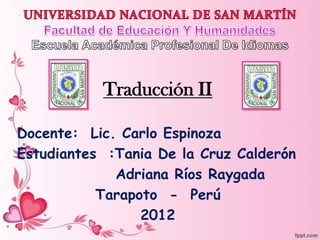
equivalence defines translation
- 1. Traducción II Docente: Lic. Carlo Espinoza Estudiantes :Tania De la Cruz Calderón Adriana Ríos Raygada Tarapoto - Perú 2012
- 2. INDEX • EQUIVALENCE DEFINES TRANLATION……………………….3 • EQUIVALENCE COULD BE ALL THINGS TO ALL THEORISTS……………………………………………………………………………..4 • EQUIVALENCE IS DIRECTIONAL AND SUBJECTLES…………………………………………………………………..8 • VALUE IS AN ECONOMIC TERM……………………………………….15 • EQUIVALENCE IS AN ECONOMIC TERM……………………..24 • EQUIVALENCE IS NOT A NATURAL RELATION BETWEEN SYSTEMS………………………………………………………………28 • EQUIVALENCE HAS BECOME UNFASHIONABLE……….32 • CONCLUSION…………………………………………………………………………..37 • BIBLIOGRAPHY………………………………………………………………………..38
- 4. EQUIVALENCE COULD BE ALL THINGS TO ALL THEORISTS Equivalence has been extensively used to define translation, but few writers have been prepared to define equivalence itself. The term would appear to be the great empty sign of such exercises.
- 5. Historical research is of little avail here. The brief survey offered by Wilss (1982, 134-135) simply presents guesses suggesting that the English term "equivalence" entered translation studies from mathematics, that it was originally associated with research into machine translation, and that it has or should have a properly technical sense.
- 6. EQUIVALENCE IS DIRECTIONAL AND SUBJECTLES DEFINITION OF TRANSLATION: Interlingual Translation may be translation can be defined as follows: defined as the the replacement of replacement of textual material in elements of one one language (SL) by language. equivalent material in another language (TL).”
- 7. Translating Translation leads from consists in a source-language text reproducing in to a target-language the receptor text which is as close language the an equivalent as closest natural possible and equivalent of the presupposes an source-language understanding of the message.” content and style of the original.”
- 8. Taking all of this together, we find that the term equivalence is commonly associated with the end result of translating as a one- way process occurring in an apparently subjectless place. Equivalence is directional and subjectless.
- 9. EQUIVALENCE IS ASYMMETRICAL Although “value” is generally not a technical term in contemporary translation studies, it does make frequent and prolonged appearances in Saussure’s Course de linguistique générale, widely held to be one of the foundational texts of modern linguistics and often cited in arguments against translatability.
- 10. It is then not surprising that Saussure’s synchronic linguistics excludes not only questions of equivalence but also all reference to one-way processes and to places of lesser dimensions than tongues. Saussure does not talk about translation. For example:
- 11. He chooses not to tell us that the difference in value between “sheep” and “mutton” is due to the historical situation in which Anglo-Saxon servants presented what they called “sceap” to their Norman masters, who called the same object “moton”.
- 12. VALUE IS AN ECONOMIC TERM Scant attention has been paid to the fact that Saussure’s uses of the term “value”— and indeed his fundamental distinction between synchronic and diachronic linguistics—were developed from analogies with economics, or more precisely from comparisons with the most prestigious social sciences of his day, political economy and economic history:
- 13. • “Here [in linguistics] as in political economy we are confronted with the notion of value; both sciences are concerned with a system for equating things of different orders—labor and wages in one, and a signified and a signifier in the other.”
- 14. According to Saussure, labor is to wages what the signified is to the signifier. But are these things of different orders really being “equated”? An economist who equated the value of wages with the value of labor would not get very far when trying to explain profits or capitalism.
- 16. David Ricardo giving textbook examples in 1812: “Water and air are abundantly useful; they are indeed indispensable to existence, yet, under ordinary circumstances, nothing can be obtained in exchange for them.
- 17. Gold, on the contrary, though of little use compared with air or water, will exchange for a great quantity of other goods. Utility then is not the measure of exchangeable value, although it is absolutely essential to it.”
- 18. EQUIVALENCE IS AN ECONOMIC TERM There is undoubtedly a certain ideological underpinning to approaches which see translation as a mode of relation between social systems and stress twentieth century use-value theories of “equivalent effects”.
- 19. If we now write “transferred text” (Y) and “translated text” (TT) in the place of “linen” and “coat”—not entirely metaphorically, since some texts are indeed bought and sold, and weaving can be as textual as it is textile That is, equivalence can be defined in terms of exchange value, expressed as a relationship between texts (TT:Y) and determined in the specific locus of the translator as a silent trader. This is what was being said but not heard.
- 20. EQUIVALENCE IS NOT A NATURAL RELATION BETWEEN SYSTEMS The suggestion that equivalence-based definitions of translation unwittingly define their object in terms of simple exchange could justify common usages of the word “equivalence”, but it by no means justifies all that is said by the contemporary theories incorporating these definitions.
- 21. Marx’s critique of use value is perhaps more interesting than the twentieth century abstractions that have followed him. He saw exchange not as a capitalist plot, but as a result of concrete intercultural communication:
- 22. EQUIVALENCE HAS BECOME UNFASHIONABLE One of the paradoxical effects of the historical increase in intercultural communications is that, through the rise of non-linguistic cultural and historical studies, there is nowadays declining interest in translational equivalence.
- 26. CONCLUSION Equivalence thus neither descends from above nor blossoms from the soil. It is a fiction without natural correlative beyond the communication situation. Yet naturalist assumptions continue to obfuscate its role as an active mode of interrelation.